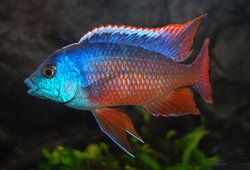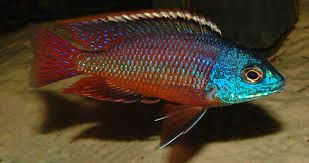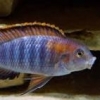As the Fish of the Month for May, there will be a bag of Protomelas taeniolatus "Namalenje" (Red Empress) around 4-6cm available at the PCS Meeting for auction. These are special lots to raise money for Stuart Grant Fund for Cichlid Preservation and have kindly been donated by one of our PCS Members - Mac.

Protomelas taeniolatus "Namalenje"
This species is from Namalenje Island, Malawi.
Common names: Red Empress.
Protomelas taeniolatus is commonly called the "Red Empress." There are a few variants of this species, Protomelas taeniolatus maleincluding a blue morph from Makanjila Point called "Blue Fire." Of the Red Empress variety, there are two classes. One morph has been "line-bred" in Europe for substantially more red color and consequently has been dubbed the "Super Red Empress." The other Red Empress morph is the American strain and has more blue color than the Super Red Empress. Adult P. taeniolatus generally attain sizes of 13-15 cm (5-6 inches), although in captivity they can certainly get much larger than this.
Size
Maximum length is around 8″ (20cm). They are known to become larger in nature.
Classification
Order: Perciformes Family: Cichlidae
Distribution
It is endemic to Lake Malawi. It has a wide distribution in the lake. Protomelas taeniolatus inhabits rocky areas of shallow, clear (no sediment) water.
Diet
It feeds mainly on algae and other microrganisms in nature and requires a high fibre diet in the aquarium. A large proportion of the diet should therefore be composed of vegetable matter such as spiriluna flake or blanced spinach/lettuce. Live and frozen brine shrimp, daphnia and bloodworm are useful supplements to this.
Meaty foods such as beefheart are detrimental to the fishes’ long term health. It is a greedy fish and is prone to becoming overweight so care must be taken when feeding.
Feeding Frequency: Several small feedings per day - Generally feed 2-3 small feedings a day rather than a single large feeding for better fish and water quality.
Maintenance
In the aquarium use piles of rocks to form lots of caves and hiding places with areas of open space for swimming between. A sandy substrate is ideal.
Due to the size of this Hap, it is not recommended that you keep it in anything smaller than 75 gallons, with 100+ gallons being the preferred minimum. This Hap needs lots of room to swim about. Due to its strong temperment, it is not a good idea to keep more than one male in the same tank unless your tank is over 200 gallons. This species is a polygamous mouthbrooder and each male should be accompanied by at least three females. Females should be given lots of potential hiding places to avoid being abused.
Temperature: 75-82°F (24-28°C) pH: 7.8-8.8 Hardness: 10-25°H
Character
This is a rather tough Protomelas species, although compared with other African Cichlids, it rarely chases or instigates fights with other tankmates but will defend territory.
A peaceful species but it is more robustthan others in the genus and can even be kept with mbuna. However, more suitable tankmates include Aulonocara, Copadichromis and other peaceful Malawi species. Males are very territorial during breeding and a very large tank would be required to keep more than one. It is also better to keep several females per male.
Spawning
Protomelas taeniolatus doesn't seem to be picky about mate selection and will spawn readily if given enough space in the aquarium. Males of this beautiful species claim only a relatively smal area that is only defended prior to and during spawning. After spawning, a male P. taeniolatus will quickly forget about his territory and will take to the open water.
A maternal mouthbrooder. For the best results, it should be spawned in a species tank. Adult fish tend to be quite expensive so a more feasible option is to start with a group of 6-8 young fish. A 48″x15″ aquarium is an adequate size and this should be furnished as suggested above. Be sure to provide some areas of open sand and flat rock surfaces to act as potential spawning sites. The pH should be around 8.0-8.5 and the temperature 77-80°F. Condition the fish on a good diet of live, frozen and dried foods.
When in condition, the male will form a small temporary territory containing either a flat rock surface or simply an area of the substrate in which he excavates a pit. He will display around this, showing intense colour, and attempt to entice females to mate with him. He can be quite aggressive in his pursuits and it is in order to dissipate this aggression that this species should be spawned in a harem. If there are other species in the tank they will not be permitted to enter the male’s territory. When a female is willing, she will approach the spawning site and lay her eggs there, allowing the male to fertilise them before taking them into her mouth. Once spawning is complete both fish leave the site, the male no longer defending it as a territory.
The female carries the eggs for around 3 weeks before releasing the free swimming fry. She will not eat during this period and can be easily spotted by her distended mouth. If a female is overly stressed, she may spit out the brood prematurely or eat them, so care must be taken if you decide to move the fish in order to avoid fry predation. Some breeders artificially strip the fry from the mother’s mouth at the 2 week stage and raise them from that point as this usually results in a larger number of fry. This method is only recommended for the expert. The fry will accept newly hatched brine shrimp or microworm immediately after they become free swimming.
Notes
One of the more popular and readily available Protomelas species in the hobby, P. taeniolatus is very similar to P. fenestratus. Several colour forms of both these species exist. Some of the popular morphs of taeniolatus include “Red Empress”, “Super Red Empress” and “Blue Fire”. It is likely that some of these may be reclassified as distinct species in the future, as they attain different maximum sizes.
None of these related species or morphs should be kept together in aquaria as they may hybridise.













